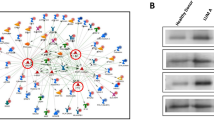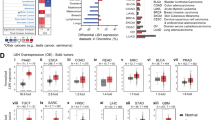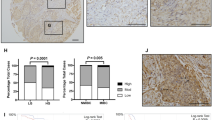Abstract
PLAG1 is a proto-oncogene whose ectopic expression can trigger the development of pleomorphic adenomas of the salivary glands and of lipoblastomas. As PLAG1 is a transcription factor, able to activate transcription through the binding to the consensus sequence GRGGC(N)6–8GGG, its ectopic expression presumably results in the deregulation of target genes, leading to uncontrolled cell proliferation. The identification of PLAG1 target genes is therefore a crucial step in understanding the molecular mechanisms involved in PLAG1-induced tumorigenesis. To this end, we analysed the changes in gene expression caused by the conditional induction of PLAG1 expression in fetal kidney 293 cell lines. Using oligonucleotide microarray analyses of about 12 000 genes, we consistently identified 47 genes induced and 12 genes repressed by PLAG1. One of the largest classes identified as upregulated PLAG1 targets consists of growth factors such as the insulin-like growth factor II and the cytokine-like factor 1. The in silico search for PLAG1 consensus sequences in the promoter of the upregulated genes reveals that a large proportion of them harbor several copies of the PLAG1-binding motif, suggesting that they represent direct PLAG1 targets. Our approach was complemented by the comparison of the expression profiles of pleomorphic adenomas induced by PLAG1 versus normal salivary glands. Concordance between these two sets of experiments pinpointed 12 genes that were significantly and consistently upregulated in pleomorphic adenomas and in PLAG1-expressing cells, identifying them as putative PLAG1 targets in these tumors.
This is a preview of subscription content, access via your institution
Access options
Subscribe to this journal
Receive 50 print issues and online access
$259.00 per year
only $5.18 per issue
Buy this article
- Purchase on SpringerLink
- Instant access to full article PDF
Prices may be subject to local taxes which are calculated during checkout



Similar content being viewed by others
Accession codes
Accessions
GenBank/EMBL/DDBJ
Abbreviations
- PLAG1 :
-
pleomorphic adenoma gene 1
- IGF-II:
-
insulin-like growth factor II
- PA:
-
pleomorphic adenoma of the salivary glands
- nsg:
-
normal salivary gland
- p57kip2:
-
cyclin-dependent kinase inhibitor 1C
- CRABP-II:
-
cellular retinoic acid-binding protein II
- CLF-1:
-
cytokine-like factor 1
- CRP2:
-
cysteine-rich protein 2
- PIGF:
-
placental growth factor
- SADV:
-
scaled average difference value
References
Alexander WS, Rakar S, Robb L, Farley A, Willson TA, Zhang JG, Hartley L, Kikuchi Y, Kojima T, Nomura H, Hasegawa M, Maeda M, Fabri L, Jachno K, Nash A, Metcalf D, Nicola NA and Hilton DJ . (1999). Curr. Biol., 9, 605–608.
Astrom AK, Voz ML, Kas K, Roijer E, Wedell B, Mandahl N, Van de Ven W, Mark J and Stenman G . (1999). Cancer Res., 59, 918–923.
Baker J, Liu JP, Robertson EJ and Efstratiadis A . (1993). Cell, 75, 73–82.
Budhu AS and Noy N . (2002). Mol. Cell. Biol., 22, 2632–2641.
Burns JL and Hassan AB . (2001). Development, 128, 3819–3830.
Coller HA, Grandori C, Tamayo P, Colbert T, Lander ES, Eisenman RN and Golub TR . (2000). Proc. Natl. Acad. Sci. USA, 97, 3260–3265.
Conway EM, Collen D and Carmeliet P . (2001). Cardiovasc. Res., 49, 507–521.
Coppock D, Kopman C, Gudas J and Cina-Poppe DA . (2000). Biochem. Biophys. Res. Commun., 269, 604–610.
Coppock DL, Kopman C, Scandalis S and Gilleran S . (1993). Cell Growth Differ., 4, 483–493.
Debiec-Rychter M, Van Valckenborgh I, Van den Broeck C, Hagemeijer A, Van de Ven WJ, Kas K, Van Damme B and Voz ML . (2001). Lab. Invest., 81, 1289–1297.
DeChiara TM, Efstratiadis A and Robertson EJ . (1990). Nature, 345, 78–80.
Dull TJ, Gray A, Hayflick JS and Ullrich A . (1984). Nature, 310, 777–781.
Elson GC, Graber P, Losberger C, Herren S, Gretener D, Menoud LN, Wells TN, Kosco-Vilbois MH and Gauchat JF . (1998). J. Immunol., 161, 1371–1379.
Elson GC, Lelievre E, Guillet C, Chevalier S, Plun-Favreau H, Froger J, Suard I, de Coignac AB, Delneste Y, Bonnefoy JY, Gauchat JF and Gascan H . (2000). Nat. Neurosci., 3, 867–872.
Frade Gonzalez C, Garcia-Caballero T, Lozano Ramirez A and Labella Caballero T . (2001). Acta Otorrinolaringol. Esp., 52, 456–460.
Grosso LE . (1996). J. Oral Pathol. Med., 25, 5–9.
Hartmann W, Waha A, Koch A, Goodyer CG, Albrecht S, von Schweinitz D and Pietsch T . (2000). Am. J. Pathol., 157, 1393–1403.
Hensen K, Van Valckenborgh IC, Kas K, Van de Ven WJ and Voz ML . (2002). Cancer Res., 62, 1510–1517.
Hibbard MK, Kozakewich HP, Dal Cin P, Sciot R, Tan X, Xiao S and Fletcher JA . (2000). Cancer Res., 60, 4869–4872.
Ito Y, Takeda T, Sasaki Y, Sakon M, Yamada T, Ishiguro S, Imaoka S, Tsujimoto M, Monden M and Matsuura N . (2002a). Liver, 22, 145–149.
Ito Y, Yoshida H, Nakano K, Kobayashi K, Yokozawa T, Hirai K, Matsuzuka F, Matsuura N, Kuma K and Miyauchi A . (2002b). Int. J. Mol. Med., 9, 373–376.
Kas K, Voz ML, Hensen K, Meyen E and Van de Ven WJ . (1998). J. Biol. Chem., 273, 23026–23032.
Kas K, Voz ML, Roijer E, Astrom AK, Meyen E, Stenman G and Van de Ven WJ . (1997). Nat. Genet., 15, 170–174.
Kusafuka K, Yamaguchi A, Kayano T, Fujiwara M and Takemura T . (1998). Virchows Arch., 432, 247–253.
Lee MH, Reynisdottir I and Massague J . (1995). Genes Dev., 9, 639–649.
Lelievre E, Plun-Favreau H, Chevalier S, Froger J, Guillet C, Elson GC, Gauchat JF and Gascan H . (2001). J. Biol. Chem., 276, 22476–22484.
Lipshutz RJ, Fodor SP, Gingeras TR and Lockhart DJ . (1999). Nat. Genet., 21, 20–24.
Matsuoka S, Edwards MC, Bai C, Parker S, Zhang P, Baldini A, Harper JW and Elledge SJ . (1995). Genes Dev., 9, 650–662.
Morin PJ, Vogelstein B and Kinzler KW . (1996). Proc. Natl. Acad. Sci. USA, 93, 7950–7954.
Oya M and Schulz WA . (2000). Br. J. Cancer, 83, 626–631.
Praz V, Perier R, Bonnard C and Bucher P . (2002). Nucleic Acids Res., 30, 322–324.
Schwienbacher C, Gramantieri L, Scelfo R, Veronese A, Calin GA, Bolondi L, Croce CM, Barbanti-Brodano G and Negrini M . (2000). Proc. Natl. Acad. Sci. USA, 97, 5445–5449.
Sell C, Dumenil G, Deveaud C, Miura M, Coppola D, DeAngelis T, Rubin R, Efstratiadis A and Baserga R . (1994). Mol. Cell. Biol., 14, 3604–3612.
Shrestha P, Sumitomo S, Ogata K, Yamada K, Takai Y, Yang L and Mori M . (1994). Eur. J. Cancer B Oral Oncol., 30B, 393–399.
Sunardhi-Widyaputra S and Van Damme B . (1993). Pathol. Res. Pract., 189, 138–143.
Sunardhi-Widyaputra S and Van Damme B . (1995). Pathol. Res. Pract., 191, 1186–1191.
Toretsky JA and Helman LJ . (1996). J. Endocrinol., 149, 367–372.
Vo HP and Crowe DL . (1998). Anticancer Res., 18, 217–224.
Voz ML, Agten NS, Van de Ven WJ and Kas K . (2000). Cancer Res., 60, 106–113.
Voz ML, Astrom AK, Kas K, Mark J, Stenman G and Van de Ven WJ . (1998). Oncogene, 16, 1409–1416.
Zhu Q, White FH and Tipoe GL . (1997). Oral Oncol., 33, 29–35.
Acknowledgements
We gratefully acknowledge N Agten, Grigory Dubois and E Meyen for technical assistance, and Bernard Peers and Sabine Tejpar for critical review of the manuscript. We also like to thank the head and neck surgeons Professor P Delaere, Professor V Vander Poorten, Dr Chr Vanclooster, Dr E Annys, Department of Otorhinolaryngology, Head and Neck Surgery and Professor J Schoenaers, Department of Oral and Maxillofacial Surgery, University Hospitals, Faculty of Medicine, Catholic University of Leuven, Leuven, Belgium for cooperation in providing the surgical specimens. We are also grateful to Professor R Sciot, Pathology Department University Hospitals, Faculty of Medicine, Catholic University of Leuven, Leuven, Belgium for histological diagnosis and Prof A Hagemmeijer and Dr M Debiec-Rychter, Laboratory for Cytogenetics and Molecular Genetics of Human Malignancies, Catholic University of Leuven, Leuven, Belgium for the cytogenetic analyses. This work was supported by the ‘Geconcerteerde Onderzoekacties 2002–2006’, the ‘Fonds voor Wetenschappelijk Onderzoek Vlaanderen (FWO)’ and the ‘Fonds National de la Recherche Scientifique’ (Televie 7.4533.01 and 7.4552.02; Credit Chercheur 1.5.108.02). MLV is a Chercheur Qualifié and HP is a Collaborateur Scientifique from the Fonds National de la Recherche Scientifique. IVV is an aspirant fellow and YM a postdoctoral fellow of the FWO. JM is a postdoctoral researcher and BDM is a full professor at the KUL, Belgium.
Author information
Authors and Affiliations
Corresponding author
Rights and permissions
About this article
Cite this article
Voz, M., Mathys, J., Hensen, K. et al. Microarray screening for target genes of the proto-oncogene PLAG1. Oncogene 23, 179–191 (2004). https://doi.org/10.1038/sj.onc.1207013
Received:
Revised:
Accepted:
Published:
Issue Date:
DOI: https://doi.org/10.1038/sj.onc.1207013
Keywords
This article is cited by
-
The Role of PLAG1 in Mouse Brain Development and Neurogenesis
Molecular Neurobiology (2024)
-
Amplification of the PLAG-family genes—PLAGL1 and PLAGL2—is a key feature of the novel tumor type CNS embryonal tumor with PLAGL amplification
Acta Neuropathologica (2023)
-
SLUG is a key regulator of epithelial-mesenchymal transition in pleomorphic adenoma
Laboratory Investigation (2022)
-
Genome-wide association analyses identify genotype-by-environment interactions of growth traits in Simmental cattle
Scientific Reports (2021)
-
Construction of miRNA-target networks using microRNA profiles of CVB3-infected HeLa cells
Scientific Reports (2019)



